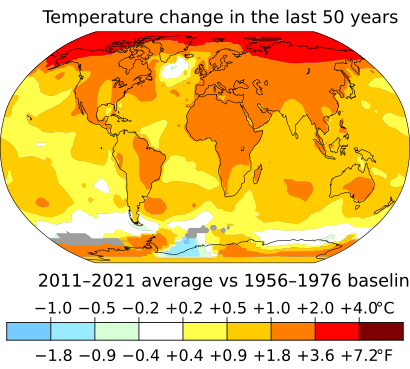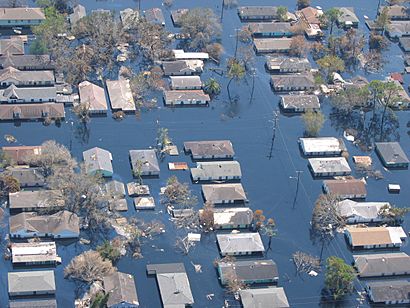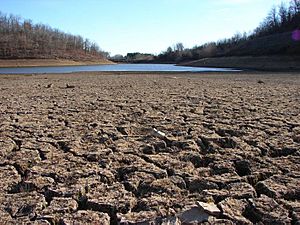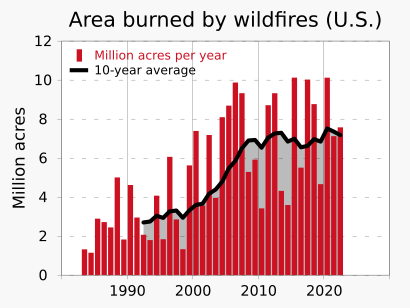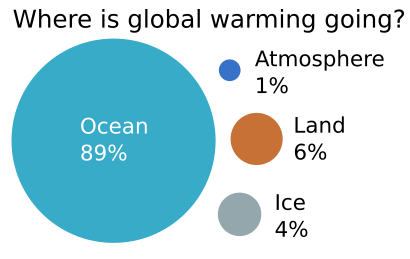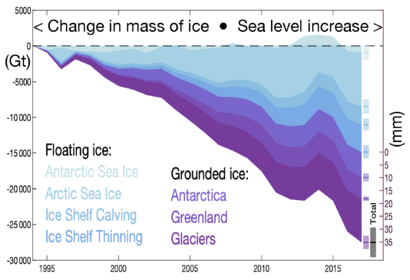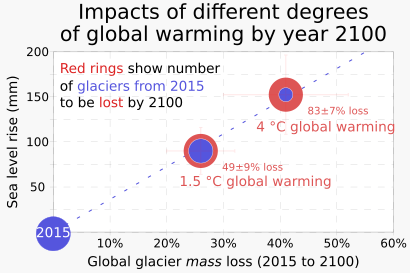Effects of climate change facts for kids
Climate change affects our planet in many ways. It changes the physical environment, nature, and human societies. The Earth is getting warmer overall. We are also seeing more extreme weather and rising sea levels. These changes impact animals, plants, and people's homes and lives. If we don't take strong action, the negative effects of human-caused climate change will be huge. Some people call this the "climate crisis."
The warming isn't the same everywhere. Land areas are warming faster than oceans. The Arctic region is warming much faster than most other places. Oceans are getting warmer, and sea levels are rising. This is due to warmer water expanding and ice melting. Carbon dioxide from the air is also making the oceans more acidic.
Recent warming has greatly affected nature. It has harmed land by making it hotter and drier. This also increases the risk of wildfires. Animals and plants are moving to colder areas. On land, many species move to higher ground. Marine species look for colder water deeper in the ocean. If the world warms by 2 degrees Celsius, about 10% of land species could become critically endangered.
Getting enough food and fresh water is at risk because of rising temperatures. Climate change also affects human health. It causes direct problems like heat stress. It also helps spread infectious diseases. How much people are affected depends on where they live and how much money they have. Richer countries, which have released the most CO2, have more ways to deal with global warming. Farming, fishing, and tourism are some areas that are greatly affected. Some groups are more at risk, like people with less money, women, children, and indigenous peoples. Climate change can also force people to move from their homes.
Changes in Temperature
Global warming affects all parts of Earth's climate system. Global surface temperatures have risen by about 1.1 degrees Celsius. They are expected to rise even more. As mentioned, land areas warm faster than oceans. The Arctic is warming faster than other regions. Also, night-time temperatures have increased more quickly than daytime temperatures. How much the environment, wildlife, and people are affected depends on how much more the Earth warms.
Scientists study past natural climate changes to predict future effects. They look at tree rings, ice cores, corals, and ocean sediments. These show that recent temperatures are higher than anything in the last 2,000 years. By the end of this century, temperatures could be as high as 3 million years ago. Back then, global temperatures were 2 to 4 degrees Celsius warmer than before the industrial age. Sea levels were up to 25 meters higher. The current rise in temperature and CO2 is happening very fast.
How much the world warms depends on human greenhouse gas emissions. It also depends on how sensitive the climate is to these gases. The more carbon dioxide (CO2) we release, the hotter the world will be by 2100. If CO2 emissions stopped suddenly, temperatures would stay high for centuries. About 20% to 30% of human-made CO2 would remain in the air for a thousand years. This would keep the climate warmer long after emissions stop.
Current plans to reduce climate change might lead to about 2.7 degrees Celsius of warming by 2100. If all countries meet their goals, warming could be around 2.4 degrees Celsius. If all countries reach their net-zero targets, warming could be about 1.8 degrees Celsius. However, there is a big gap between what countries promise and what they actually do.
Weather Changes
The lower and middle parts of the atmosphere are heating up. This is where most weather happens. As temperatures rise, more water evaporates and enters the air. Water vapor is also a greenhouse gas. This creates a cycle that makes warming worse.
Extra water vapor makes storms more intense, larger, and last longer. This causes rain and snow events to be stronger. It also increases the risk of flooding. More drying makes natural dry spells and droughts worse. It also increases the risk of heat waves and wildfires. Scientists can now tell how much climate change affects extreme weather events. For example, they can show that a specific heatwave was more intense because of climate change.
Heat Waves and Temperature Extremes
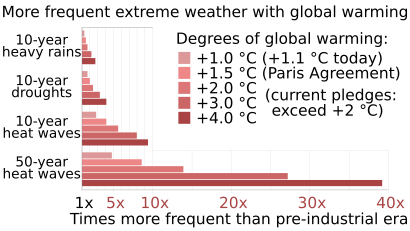
Heatwaves over land have become more frequent and intense since the 1950s. This is due to climate change. Heatwaves are also more likely to happen at the same time as droughts. Heatwaves in the ocean are now twice as likely as they were in 1980. Climate change will bring more very hot days and fewer very cold days. There will be fewer cold waves.
The strength of individual heatwaves can often be linked to global warming. Some extreme events would have been almost impossible without human influence. A heatwave that used to happen once every ten years now happens 2.8 times more often. With more warming, heatwaves will become even more frequent. An event that used to happen every ten years could happen every other year if global warming reaches 2 degrees Celsius.
Heat stress is not just about temperature. It also increases with higher humidity. The wet-bulb temperature measures both. Above 35 degrees Celsius wet-bulb temperature, heat stress is deadly for humans. If global warming stays below 1.5 or 2 degrees Celsius, this deadly heat can likely be avoided in most tropical areas. But there could still be negative health impacts.
Rain and Snow
Warming increases the total amount of rain and snow globally. Higher temperatures lead to more evaporation and drier surfaces. As the air warms, it can hold more water. It holds 7% more water vapor for every degree Celsius. Changes have already been seen in how much, how strong, how often, and what type of rain and snow falls. Overall, climate change is causing longer hot, dry periods. These are broken by more intense, heavy rainfall.
Climate change has made rainfall differences bigger between wet and dry seasons. Wet seasons are getting wetter, and dry seasons are getting drier. In northern polar regions, warming has also increased snow and rain. In the Southern Hemisphere, storm tracks have moved south. Monsoon changes vary a lot. More monsoon systems are getting wetter than drier.
Extreme Storms
Storms, including tropical and extratropical cyclones, become wetter with climate change. Both the highest and average rainfall rates increase. This more extreme rainfall also happens with thunderstorms in some areas. Also, tropical cyclones and storm tracks are moving towards the poles. This means some regions will see big changes in maximum wind speeds. There will likely be fewer tropical cyclones, but their strength is expected to increase. There has also likely been an increase in tropical cyclones that get stronger very quickly.
Impacts on Land
Floods
-
Long-term sea level rise occurs in addition to intermittent tidal flooding. NOAA predicts different levels of sea level rise for coastlines within a single country.
Because of more heavy rainfall, floods are expected to become more severe when they happen. However, how rain affects flooding is complicated. In some regions, flooding might become rarer. This depends on changes in rain and snowmelt, and also on soil moisture. For example, climate change makes soils drier in some areas. So, they might soak up rainfall faster, leading to less flooding. But dry soils can also become harder. This causes heavy rainfall to run off into rivers and lakes, increasing flood risks.
Droughts
Climate change affects many things linked to droughts. This includes how much rain falls and how fast it evaporates. Warming over land increases how severe and often droughts happen around the world. In some tropical and subtropical regions, there will likely be less rain. This makes them more likely to have droughts. These regions include Central America, the Amazon, parts of South America, West and Southern Africa, the Mediterranean, and southwestern Australia.
Higher temperatures lead to more evaporation. This dries out the soil and stresses plants. This will affect farming. Even regions where rainfall stays stable, like central and northern Europe, will feel these impacts. Without action on climate change, about a third of land areas could experience moderate or worse drought by 2100. Droughts are more frequent and intense now than in the past.
Their impacts are made worse by more water use, population growth, and city expansion. Restoring land, especially through agroforestry, can help reduce drought impacts.
Wildfires
Climate change creates weather that makes wildfires more likely. In some areas, more wildfires have been directly linked to climate change. Evidence from Earth's past also shows more fires in warmer times. Climate change increases evaporation, which can dry out plants. When a fire starts in very dry plants, it can spread quickly. Higher temperatures can also make the fire season longer. This is especially true where snow is disappearing.
Even though weather conditions raise wildfire risks, the total area burned by wildfires has gone down. This is mainly because savannas have been turned into farmland. So, there are fewer trees to burn. Controlled burning, an old practice in the US and Australia, can reduce wildfires. The carbon released from wildfires can increase greenhouse gases even more.
Oceans
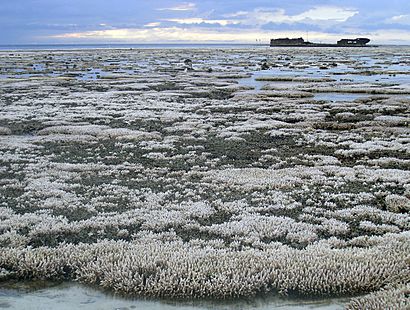
The ocean is a huge part of Earth's climate system. It covers about 70% of the planet's surface. The ocean has absorbed most of the extra heat from global warming. It has also taken in about a quarter of the carbon dioxide that humans have released into the atmosphere. This has led to several big changes in the ocean.
One major change is that the ocean is getting warmer. The top layers of the ocean are warming quickly. This warming goes deep into the ocean. Warmer oceans affect marine life and contribute to sea level rise.
Another big problem is ocean acidification. When the ocean absorbs carbon dioxide, it becomes more acidic. This makes it harder for many marine animals, like corals and shellfish, to build their shells and skeletons. This can harm entire ocean ecosystems.
Sea Level Rise
Global sea level has been rising for over a century. This rise is speeding up. The main reasons are the expansion of warming ocean water and the melting of glaciers and ice sheets. Since 1900, the global average sea level has risen by about 15 to 25 centimeters. About a third of this rise happened in the last 25 years.
Sea level rise will continue for centuries, even if global temperatures stop rising. This is because deep ocean waters warm slowly. Also, ice sheets take a long time to melt. Even if warming is limited to 1.5 degrees Celsius, global sea level will still rise by 2 to 3 meters over 2,000 years. If warming reaches 5 degrees Celsius, it could rise by 19 to 22 meters over the same period.
Ice and Snow
The cryosphere is the part of Earth covered by snow or ice. It is very sensitive to climate changes. There has been a lot of snow loss on land since 1981. The biggest drops have been in the spring. Snow cover is expected to keep shrinking in almost all regions this century.
Glaciers and Ice Sheets Declining
Glaciers have been shrinking worldwide since the early 1900s. Glaciers not connected to polar ice sheets lost about 8% of their mass between 1971 and 2019. In the Andes (South America) and Himalayas (Asia), melting glaciers could affect water supplies. Their melting could also cause landslides or floods from glacial lakes.
The melting of the Greenland ice sheet and West Antarctic ice sheet will keep adding to sea level rise for a long time. Greenland's ice loss is mainly from melting on top. Antarctic ice loss is from warm ocean water melting the ice from below.
The West Antarctic ice sheet could melt quickly if emissions are high. Part of this ice sheet rests on bedrock below sea level. This makes it vulnerable to a process where melting speeds up melting. If this ice sheet collapses partially, it would cause rapid sea level rise. It would also lower ocean saltiness nearby. This change would be permanent for hundreds to thousands of years. If the West Antarctic ice sheet completely melts, it would cause over 5 meters of sea level rise.
In contrast, the Greenland ice sheet is expected to melt more slowly, over thousands of years. If warming stays between 1 and 4 degrees Celsius, the entire ice sheet could melt. This would add 7 meters to global sea levels. The ice loss could become permanent due to a feedback loop. As ice melts, the ice sheet gets lower. Since air is warmer at lower altitudes, this causes even more melting.
Sea Ice Decline
Sea ice reflects 50% to 70% of sunlight back into space. The ocean only reflects 6%. As the climate warms, the area covered by snow or sea ice shrinks. When sea ice melts, the ocean absorbs more energy, making it warmer. This ice-albedo feedback makes climate change worse. We've only been able to measure sea ice on a large scale since satellites.
Sea ice in the Arctic has shrunk in recent decades. It has lost area and volume due to climate change. It melts more in summer than it refreezes in winter. The decline in Arctic sea ice has sped up this century. It has shrunk by over 50% since satellite records began. Ice-free summers are expected to be rare at 1.5 degrees Celsius warming. But they are set to happen at least once every decade at 2 degrees Celsius warming. The Arctic will likely become ice-free at the end of some summers before 2050.
Sea ice around Antarctica changes a lot year by year. This makes it hard to see a clear trend. Both record highs and lows have been seen between 2013 and 2023. The general trend since 1979 has been mostly flat. There has been a decline between 2015 and 2023. But because of the high variability, this is not a statistically significant trend.
Permafrost Thawing
Permafrost is ground that stays frozen for at least two years. Globally, permafrost warmed by about 0.3 degrees Celsius between 2007 and 2016. The area of permafrost has been shrinking for decades, and more decline is expected. When permafrost thaws, the ground becomes weaker and unstable. In areas with a lot of permafrost, nearby human structures like railways, towns, and pipelines can be severely damaged.
Also, thawing soil can release methane and CO2. These are greenhouse gases from decaying plants and animals. This can create a strong feedback loop that makes global warming worse. Scientists believe that permafrost holds about 1600 gigatons of carbon. This is twice the amount in the atmosphere.
Wildlife and Nature
Recent warming has greatly affected natural biological systems. Species worldwide are moving towards the poles to colder areas. On land, species may move to higher elevations. Marine species find colder water at greater depths. Climate change is the third biggest global impact on nature over the last five decades. Only changes in land and sea use, and directly taking organisms, have had a greater impact.
The effects of climate change on nature are expected to become stronger in the next few decades. The stress from climate change, added to other problems like habitat loss and pollution, threatens to severely damage or completely destroy some unique ecosystems. It also threatens to cause species extinction. Important interactions between species in ecosystems are often broken. This happens because species don't leave warming habitats at the same rate. This leads to rapid changes in how ecosystems work. Impacts include changes in regional rainfall, earlier leafing of trees and plants, changes in bird migrations, and shifting of ocean plankton and fish.
These changes in land and ocean ecosystems directly affect human well-being. For example, ocean ecosystems help protect coasts and provide food. Freshwater and land ecosystems provide fresh water for people. These ecosystems can also store carbon, which helps stabilize climate change.
Ecosystems on Land
Climate change is a major cause of biodiversity loss in cool conifer forests, savannas, Mediterranean climates, tropical forests, and the Arctic tundra. In other ecosystems, land-use change might be a stronger cause of biodiversity loss, at least for now. After 2050, climate change might be the main cause of biodiversity loss globally. Climate change works with other pressures like habitat change, pollution, and invasive species. Together, these increase the risk of extinction for many land and freshwater species. At 1.2 degrees Celsius of warming (around 2023), some ecosystems are threatened by mass tree die-offs and heatwaves. At 2 degrees Celsius of warming, about 10% of land species could become critically endangered. This varies by group. For example, insects and salamanders are more at risk.
Rainfall in the Amazon rainforest is recycled. It evaporates back into the air instead of running off. This water is vital for the rainforest. Due to deforestation, the rainforest is losing this ability. Climate change makes it worse by bringing more frequent droughts. The higher number of droughts in the early 21st century suggests that a tipping point from rainforest to savanna might be near. A 2019 study said this ecosystem could start collapsing to a savanna around 2021. After that, it would become much harder to stop or reverse this change.
Marine Ecosystems
Marine heatwaves are happening more often. They have widespread impacts on ocean life. These include mass dying events and coral bleaching. Harmful algae blooms have increased due to warming waters, less oxygen, and pollution. Melting sea ice destroys habitats, including for algae that grow on its underside.
Ocean acidification has many potentially harmful effects on marine organisms. Animals that form shells, like oysters, are especially vulnerable. Some phytoplankton and seagrass species might benefit. However, this also includes phytoplankton species that are toxic to fish. Their spread risks fisheries and aquaculture. Fighting pollution can reduce the impacts of acidification.
Warm water coral reefs are very sensitive to global warming and ocean acidification. Coral reefs provide a home for thousands of species. They also offer ecosystem services like coastal protection and food. Reefs can become stronger by reducing local pollution and overfishing. But 70–90% of today's warm water coral reefs will disappear even if warming is kept to 1.5 degrees Celsius. Coral reefs build physical structures that create habitats for other sea creatures. Other framework organisms are also at risk from climate change. For example, mangroves and seagrass are at moderate risk with lower levels of global warming.
Tipping Points and Irreversible Impacts
Self-reinforcing feedbacks can make climate change worse. The climate system shows "threshold behavior" or tipping points. This happens when these feedbacks push parts of the Earth system into a new state. Examples include the unstoppable loss of ice sheets or the death of forests. Tipping behavior is found across the climate system. It affects ecosystems, ice sheets, and ocean and atmosphere circulation. Scientists study tipping points using data from Earth's past and physical models. There is already a moderate risk of global tipping points at 1 degree Celsius above pre-industrial temperatures. That risk becomes high at 2.5 degrees Celsius. It's possible that some tipping points are close to being crossed or have already been crossed. These include the West Antarctic and Greenland ice sheets, the Amazon rainforest, and warm-water coral reefs.
Tipping points are "perhaps the most 'dangerous' aspect of future climate changes." They lead to permanent impacts on society. For example, a collapse of the Atlantic meridional overturning circulation would likely cut rainfall in India in half. It would also cause severe temperature drops in Northern Europe. Many tipping points are linked. Triggering one might lead to a chain of effects, even well below 2 degrees Celsius of warming. A 2018 study said that 45% of environmental problems, including those from climate change, are connected. This makes the risk of a domino effect bigger.
Other impacts may also be permanent, at least for many human generations. In the physical environment, this includes warming of the deep ocean and acidification. These will continue even if global temperatures stop rising. In nature, the extinction of species would be a permanent impact. In societies, unique cultures may be lost. The disappearance of endangered languages may get worse due to climate change.
Health, Food, and Water Security
Humans have a climate niche. This is a certain range of temperatures where they thrive. Outside that niche, conditions are less favorable. This leads to negative effects on health, food security, and more. As of May 2023, 60 million people lived outside this niche (where the average yearly temperature is above 29°C). But with every extra 0.1 degree of warming, 140 million more people will be pushed out of it.
Health
Climate change affects human health in many ways. It causes more heat-related illnesses and deaths. This is due to more frequent and intense heatwaves. It also makes air pollution worse. This leads to more breathing problems.
Climate change also affects the spread of diseases. Warmer temperatures and changes in rainfall can expand the areas where disease-carrying insects, like mosquitoes, can live. This can lead to more cases of diseases like malaria and dengue fever. Changes in water quality can also lead to more waterborne diseases.
Climate change can also affect mental health. People may feel stress, anxiety, or sadness about the future. They might also experience trauma from extreme weather events. Losing homes or livelihoods can also cause mental health problems.
Food Security
Climate change will affect farming and food production worldwide. This is due to higher CO2 in the air, warmer temperatures, and changes in rain. It also brings more extreme weather. And it changes how weeds, pests, and diseases affect crops. Droughts cause crop failures and loss of pasture for livestock. Loss and poor growth of livestock mean less milk and meat. Soil erosion is 10–20 times higher than soil buildup in farms that don't use tilling. In areas with tilling, it's 100 times higher. Climate change makes this land damage and desertification worse.
Climate change is expected to negatively affect all four parts of food security. This includes how much food is available, how easy it is to get (prices), food quality, and how stable the food system is. For example, climate change is already affecting how much wheat and other key foods are produced.
In many areas, fisheries have already seen their catch decrease. This is because of global warming and changes in ocean cycles. Along with overfishing, warming waters reduce the amount of fish in the ocean. For every degree of warming, ocean life is expected to decrease by about 5%. Tropical and subtropical oceans are most affected. There might be more fish in polar waters.
Water Security
Water resources can be affected by climate change in several ways. The total amount of fresh water available can change. This happens due to dry spells or droughts. Heavy rainfall and flooding can affect water quality. Pollutants can be carried into water bodies by increased surface runoff. In coastal regions, more salt may enter water resources due to higher sea levels and stronger storms. Higher temperatures also directly harm water quality. Warm water holds less oxygen. Changes in the water cycle threaten current and future water systems. It will be harder to plan investments for water systems because there is much uncertainty about future water cycle changes.
Between 1.5 and 2.5 billion people live in areas with regular water security problems. If global warming reaches 4 degrees Celsius, water insecurity would affect about twice as many people. Water resources are expected to decrease in most dry subtropical and mid-latitude regions. But they might increase in high latitudes. However, as streamflow becomes more variable, even regions with more water can have short-term shortages. The dry regions of India, China, the US, and Africa are already seeing dry spells and drought affect water availability.
Human Settlements
The Arctic, Africa, small islands, Asian megadeltas, and the Middle East are regions likely to be especially affected by climate change. Low-latitude, less-developed regions are most at risk of negative impacts. The ten countries of the Association of Southeast Asian Nations (ASEAN) are among the most vulnerable. However, ASEAN's efforts to reduce climate change are not matching the threats they face.
Impacts from Heat
Areas where a third of the human population lives could become as hot as the hottest parts of the Sahara within 50 years. This would happen if population growth patterns don't change and people don't move. This is also if greenhouse gas emissions keep growing fast. The projected average temperature of above 29 degrees Celsius for these regions would be outside the "human temperature niche." This is a suggested climate range suitable for humans. The most affected regions have little ability to adapt.
Increased extreme heat from climate change and the urban heat island effect threatens cities. This is made worse by the loss of shade from urban trees that cannot handle the heat.
In 2019, the Crowther Lab at ETH Zurich compared the climate of 520 major cities today with their predicted climate in 2050. 22% of major cities are expected to have climates that don't exist in any city today. For example, 2050 London will feel like 2019 Melbourne in Australia. Athens and Madrid will feel like Fez in Morocco. Nairobi in Kenya will feel like Maputo in Mozambique. The Indian city Pune will be like Bamako in Mali. Bamako will be like Niamey in Niger. Brasilia will be like Goiania, both in Brazil.
Low-lying Coastal Regions
Cities and other settlements near the sea face many risks from climate change. Besides flooding from sea level rise, they may face impacts from stronger storms, ocean acidification, and salt entering groundwater. Societal changes increase these risks, such as continued building in exposed areas.
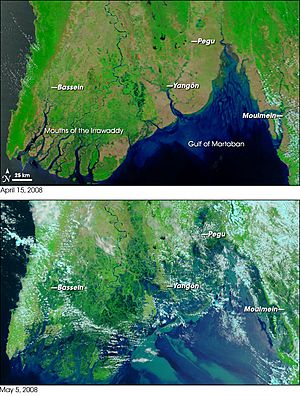
Given high coastal population density, estimates of people at risk of coastal flooding vary. It ranges from 190 million to 300 million or even 640 million in a worst-case scenario. This worst case is linked to the instability of the Antarctic ice sheet. Most affected people are in the crowded, low-lying megadeltas of Asia and Africa.
Small island developing states are especially vulnerable. They are expected to experience more intense storm surges, saltwater intrusion, and coastal damage. Low-lying small islands in the Pacific, Indian, and Caribbean regions are at risk of permanent flooding and people having to move. On the islands of Fiji, Tonga, and western Samoa, people who moved from outer islands live in low and unsafe coastal areas. Small atoll nations like Kiribati, Maldives, the Marshall Islands, and Tuvalu are at risk of their entire populations having to move. Losing these islands could lead to problems of statelessness. Vulnerability is increased by small size, isolation, low money, and lack of protective buildings.
Impacts on Societies
Climate change affects health, drinking water, food, inequality, and economic growth. The effects of climate change are often linked. They can make each other worse, as well as existing problems. Some areas may become too hot for humans to live in. People in some areas may be forced to move within their countries or to other countries due to climate-related changes or disasters.
The effects of climate change, combined with rising greenhouse gas emissions, have led some scientists to call it a "climate emergency" or "climate crisis". Some climate researchers and activists call it an "existential threat to civilization." Some define these threats under the field of climate security. The results of climate change, and failing to deal with it, can take away focus and resources from solving its root causes. Researchers call this a "climate doom loop."
Displacement and Migration
Climate change affects people moving in several ways. First, forced movement may increase due to more frequent and severe weather disasters. These destroy homes and habitats. Effects like desertification and rising sea levels slowly destroy livelihoods. They force communities to leave their traditional homelands. Other types of migration are chosen and voluntary. These are based on individual or family decisions. On the other hand, some families may become poorer due to climate change. This limits their ability to move to less affected areas.
Migration due to climate and weather is usually within a country, but over long distances. Slow-onset disasters like droughts and heat are more likely to cause long-term migration than weather disasters like floods. Migration due to desertification and less fertile soil is likely to be mainly from rural areas in developing countries to towns and cities.
According to the Internal Displacement Monitoring Centre, about 30 million people were displaced by extreme weather events in 2020. In the same year, about 10 million were displaced by violence and wars. Climate change may have contributed to these conflicts. In 2018, the World Bank estimated that climate change will cause 31 to 143 million people to move within their own countries by 2050. They will be escaping crop failures, water shortages, and sea level rise. The study only included Sub-Saharan Africa, South Asia, and Latin America.
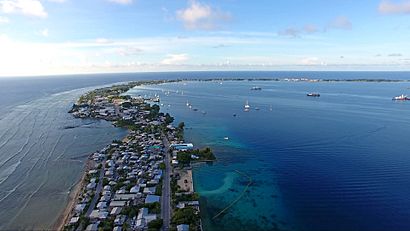
Conflict
Climate change can worsen water conflicts and tensions over other limited resources. Climate change also has the potential to cause large numbers of people to move. This can also lead to increased tensions. However, other factors were much more important in causing conflict over the last century. These factors include unfairness between groups and low economic development. In some cases, climate change can even lead to more peaceful relationships. This happens when environmental problems require groups to work together on solutions.
Global warming has been called a "threat multiplier." Conditions in certain places make it more likely that climate change impacts will cause conflict. These include ethnic exclusion, an economy based on farming, poor infrastructure, bad local government, and low development. A sharp rise in wheat prices after crop losses from a drought may have contributed to the "Arab Spring" protests and revolutions in 2010.
Economic Impacts
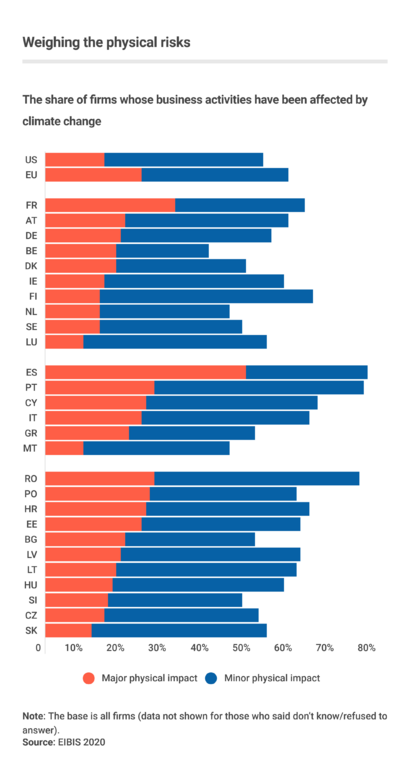
Economic predictions of global warming's impact vary a lot. But they are worse if there is only limited adaptation. Economic models might underestimate the impact of potentially huge climate changes. When estimating losses, economists choose a discount rate. This determines how much one prefers to have something now compared to later. Choosing a high discount rate might make economic losses seem smaller. This is because losses for future generations are given less importance.
Total economic impacts increase with higher temperature rise. For example, total damages are estimated to be 90% less if global warming is limited to 1.5 degrees Celsius. This is compared to 3.66 degrees Celsius, a warming level representing no action. One study found a 3.5% reduction in global GDP by the end of the century if warming is limited to 3 degrees Celsius. This excludes the possible effect of tipping points. Another study noted that global economic impact is underestimated by two to eight times when tipping points are not included. In a high-emission scenario, a temperature rise of 2 degrees Celsius by 2050 would reduce global GDP by 2.5%–7.5%. By 2100 in this scenario, the temperature would rise by 4 degrees Celsius. This could reduce global GDP by 30% in the worst case.
Global losses show rapidly rising costs due to extreme weather events since the 1970s. Social and economic factors have contributed to this trend. These include population growth and increased wealth. Part of the growth is also linked to regional climate factors, like changes in rainfall and flooding. It is hard to measure how much social-economic factors and climate change each contribute to the trend. However, the trend suggests that social systems are becoming more vulnerable to climate change.
Economic Inequality
Climate change has made global economic inequality worse. Rich countries in colder regions have felt little overall economic impact from climate change. Some may have even benefited. But poor, hotter countries very likely grew less than they would have without global warming.
Highly Affected Sectors
Economic areas directly affected by weather are more impacted by climate change. For example, farming, fishing, and forestry are all heavily affected. Tourism and energy sectors are also impacted. Farming and forestry have suffered economic losses due to droughts and extreme heat, for instance in Europe. If global warming goes above 1.5 degrees, there may be limits to how much existing tourism and outdoor work can adapt.
In the energy sector, thermal power plants need water for cooling. Climate change can increase the chance of drought and fresh water shortages. Also, higher operating temperatures reduce their efficiency and output. Hydropower is affected by changes in the water cycle, like river flows. Less river flow can cause power shortages in areas that rely heavily on hydroelectric power. Brazil is especially vulnerable because it depends on hydroelectricity. Rising temperatures, lower water flow, and changes in rainfall could reduce total energy production by 7% annually by the end of the century. Oil and natural gas infrastructure is affected by climate change and the increased risk of disasters like storms, cyclones, flooding, and rising sea levels.
The insurance and financial services sectors are impacted by global warming. Insurance helps manage risks, but it's often not available to poorer families. Due to climate change, prices for certain types of insurance, like flood insurance, are going up. Poor adaptation to climate change further widens the gap between what people can afford and insurance costs, as risks increase. In 2019, Munich Re noted that climate change could make home insurance too expensive for families with average or lower incomes.
Social Impacts on Vulnerable Groups
Climate change does not affect everyone in the same way. Vulnerable groups like women, the elderly, religious minorities, and refugees may be more impacted by climate change than others.
- People living in poverty: Climate change affects poor people in low-income communities and developing countries more. Those in poverty are more likely to experience the bad effects of climate change. This is because they are more exposed and vulnerable. A 2020 World Bank paper estimated that 32 million to 132 million more people will be pushed into extreme poverty by 2030 due to climate change.
- Women: Climate change increases gender inequality. It reduces women's ability to be financially independent. It also has a negative impact on the social and political rights of women. This is especially true in economies that rely heavily on farming.
- Indigenous peoples: Indigenous communities often rely more on the environment for food and other needs. This makes them more vulnerable to changes in ecosystems. Indigenous communities worldwide often have economic disadvantages. These are not as common in non-indigenous communities. This is due to the unfair treatment they have faced. These disadvantages include less access to education and jobs, and higher rates of poverty. These add to their vulnerability to climate change.
- Children: A review on health and climate change lists children among those most affected by global warming. Children are 14–44 percent more likely to die from environmental factors.
See also
 In Spanish: Efectos del calentamiento global para niños
In Spanish: Efectos del calentamiento global para niños
- Anthropocene
- Global catastrophic risk
- Politics of climate change
Images for kids


